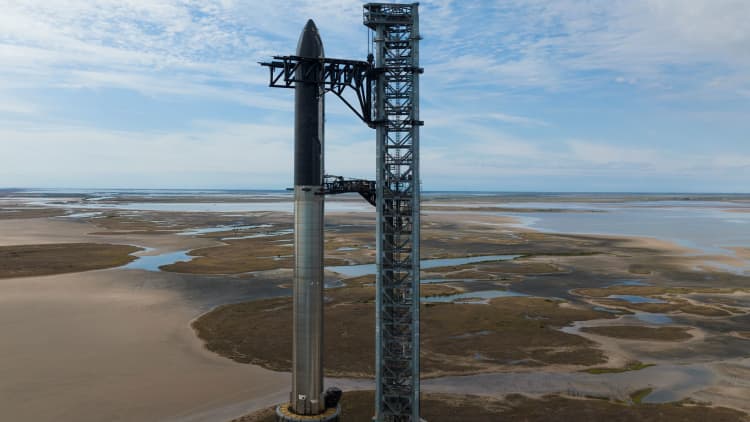
SpaceX conducted the fourth test flight of its Starship rocket on Thursday, as the company hopes to push the behemoth’s development to new milestones.
Elon Musk’s company launched Starship from the Starbase facility near Boca Chica, Texas, around 8:50 a.m. ET.
Assuming the launch goes as planned, the Starship will reach space, then fly half-circle around the Earth before re-entering the atmosphere and landing in the Indian Ocean.
On March 14, 2024, SpaceX’s next-generation Starship spacecraft, equipped with the powerful Super Heavy rocket, conducted its third unmanned test flight at the Boca Chica launch pad near Brownsville, Texas, USA.
Cheney Orr | Reuters
So far, SpaceX has conducted three aerospace tests of the complete Starship rocket system, launching in April, November and March 2023. Each test flight achieved more milestones than the last, but each ended in destroying the rocket before the flight was over.
The company’s rocket flew its furthest on its third test flight, which allowed SpaceX to test new capabilities, including opening and closing payload doors in space (which will be how the rocket deploys payloads such as satellites on future missions) and transporting fuel during launch.
Sign up here to receive the weekly edition of CNBC’s Space Investing Newsletter.
Starship systems are designed to be fully reusable and intended to be a new way to transport cargo and people beyond Earth. The rocket is also critical to NASA’s plans to return astronauts to the moon. SpaceX won a multibillion-dollar contract from the agency to use Starship as a crewed lunar lander as part of NASA’s Artemis lunar program.
SpaceX places a strong emphasis on “building on what we’ve learned from previous flights” in its approach to developing Starship. The company says its strategy is focused on “recursive improvements” to its rockets, and even the enthusiastic test flights represent progress toward its goal of fully reusable rockets that could send humans to the moon and Mars.
Musk said last year that he expected the company to spend about $2 billion on Starship development by 2023.
fourth flight target
SpaceX’s next-generation Starship spacecraft, mounted on its powerful Super Heavy rocket, is preparing for its third unmanned test flight on March 13, 2024, from the company’s Boca Chica launch pad near Brownsville, Texas, USA.
Joe Skipper | Reuters
There won’t be anyone involved in this attempt to reach space on a starship. Company leadership has previously stressed that SpaceX expects to fly hundreds of Starship missions with any crew before a rocket launches.
SpaceX will look to surpass the milestone of a third test flight. The company wrote in an update on its website that the fourth flight “shifts our focus from reaching orbit to demonstrating the ability to return and reuse Starship and Super Heavy.”
“The primary goal is to perform a landing burn and soften splashdown in the Gulf of Mexico using the Super Heavy booster and enable controlled entry of Starship,” SpaceX wrote.
The company said it has completed a series of software and hardware changes to Starship aimed at improving the rocket’s reliability.
Rocket

Starship is the tallest and most powerful rocket ever launched. Starship, fully stacked on Super Heavy boosters, is 397 feet tall and about 30 feet in diameter.
The Super Heavy booster is 232 feet tall and is the starting point for the rocket’s journey into space. There are 33 Raptor engines on the bottom, which can produce a total of 16.7 million pounds of thrust, about twice the 8.8 million pounds of thrust of NASA’s Space Launch System rocket. First launched in 2022.
The starship itself is 165 feet tall and has six Raptor engines – three for use in Earth’s atmosphere and three that operate in the vacuum of space.
The rocket is powered by liquid oxygen and liquid methane. The entire system requires more than 10 million pounds of propellant to launch.






